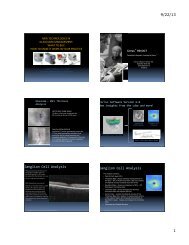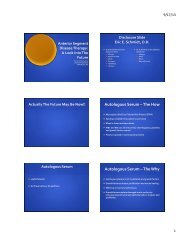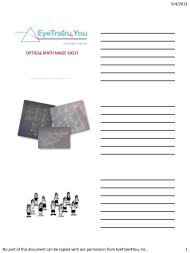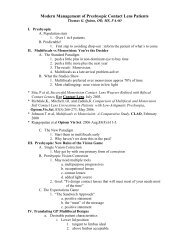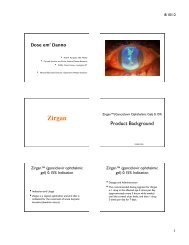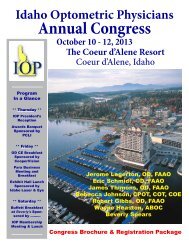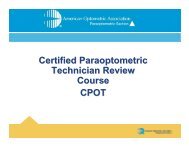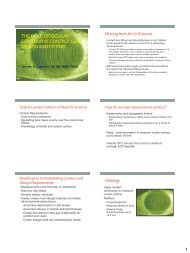Series 5 coding Power Point 92010 - Idaho Optometric Physicians
Series 5 coding Power Point 92010 - Idaho Optometric Physicians
Series 5 coding Power Point 92010 - Idaho Optometric Physicians
Create successful ePaper yourself
Turn your PDF publications into a flip-book with our unique Google optimized e-Paper software.
10/29/2010Choosing A 92000 Code• As with all services, use these codes only when thecontents of the record matches the definitions in CPT• Most visits can be reported using either 99000 or 92000codes• 92000 office visit codes are most frequently used for eyecare visits…invite audits• Must code correctly to– Receive proper reimbursement– Avoid audit problemsObvious Differences Between99000 and 92000 Codes• Requirements for 92000 codes are more generalthan those for the 99000 codes– 92002‐92014 require ‘history’– 99000 series requires certain levels of history of presentillness, review of systems and past/family/social history– 92002‐92014 require external and adnexal exam– 99000 series include specific requirements for adnexae(lids/lac. Glands/drainage/orbits/nodes)Considerations for 92000 vs 99000• About 75% of visits can be billed as a 99000 code ora 92000 code• How to decide?– Higher reimbursement for one or other– Record more clearly supports one or other– Patient’s insurer requires using one set or other– Your in‐office protocol requires 92000 for non medicalservices and 99000 for medical?– Other reasons?General Ophthalmological Servicecodes are…– Designed to report medical eye care visits– May be used to report routine eye careNote: Refraction is a separate service (92015) andis not included in any other code, unlessrequired by contract with payer…92014/92004does not include refraction!CPT Definition for IntermediateOphthalmological Services…92002/92012Note: Current Procedural Terminology( © American MedicalAssociation) is the only accepted source of definitions forthese services.“Intermediate ophthalmological services describes anevaluation of a new or existing condition complicated witha new diagnostic or management problem not necessarilyrelating to the primary diagnosis, including history, generalmedical observation, external ocular and adnexalexamination and other diagnostic procedures as indicated;may include the use of mydriasis forophthalmoscopy…with initiation (or continuation) ofdiagnostic and treatment program.”New (92002) or established patient (92012)Requirements of IntermediateOphthalmological ServicePayers often develop their own interpretations ofthese definitions, but the elements that areclearly included in the CPT definition are:1. A new or existing condition…2. complicated with a new diagnostic or managementproblem not necessarily relating to the primary diagnosis3. History4. General medical observation7



